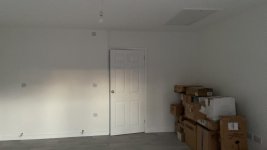keenly
New member
- Thread Author
- #1
Hi everyone
I have recently moved into converted garage-bedroom in Northumberland, UK. Pics show room.
I have been researching audio treatment for 2 years now and made the decision to purchase some some panels before moving. I presumed, based on what I thought I knew, that these would smooth the bass out. I watched many Dennis foley videos and he says every small room has issues with 30-100hz. I could not find anything in the UK to go down to 30hz, but RPG go down to 35hz. I figured these would not deaden the room so no harm could be done.
I intend on setting up 7.2.4 Atmos system, but only have a 2 channel one right now. I have rel subs and have tested 1, in 1 position. This was just before putting panels on wall. Bass is almost non existent on left side of mlp, particularly when stood up, and right side of room has excessive bass.
I have got my brother in law to put up 10 panels for me. Mostly on front and back walls where I believed most pressure would be. The front side walls in corners also have panels; left and right. I can post pics later(right now there is stuff everywhere).
The £5000 I have spent has not helped one bit. Bass sounds worse than last room which was same size and had no treatment. I am totally devastated by this. Bass is all over the place and music is not enjoyable at all.
Any thoughts would be appreciated, cheers.
I have recently moved into converted garage-bedroom in Northumberland, UK. Pics show room.
I have been researching audio treatment for 2 years now and made the decision to purchase some some panels before moving. I presumed, based on what I thought I knew, that these would smooth the bass out. I watched many Dennis foley videos and he says every small room has issues with 30-100hz. I could not find anything in the UK to go down to 30hz, but RPG go down to 35hz. I figured these would not deaden the room so no harm could be done.
I intend on setting up 7.2.4 Atmos system, but only have a 2 channel one right now. I have rel subs and have tested 1, in 1 position. This was just before putting panels on wall. Bass is almost non existent on left side of mlp, particularly when stood up, and right side of room has excessive bass.
I have got my brother in law to put up 10 panels for me. Mostly on front and back walls where I believed most pressure would be. The front side walls in corners also have panels; left and right. I can post pics later(right now there is stuff everywhere).
The £5000 I have spent has not helped one bit. Bass sounds worse than last room which was same size and had no treatment. I am totally devastated by this. Bass is all over the place and music is not enjoyable at all.
Any thoughts would be appreciated, cheers.




